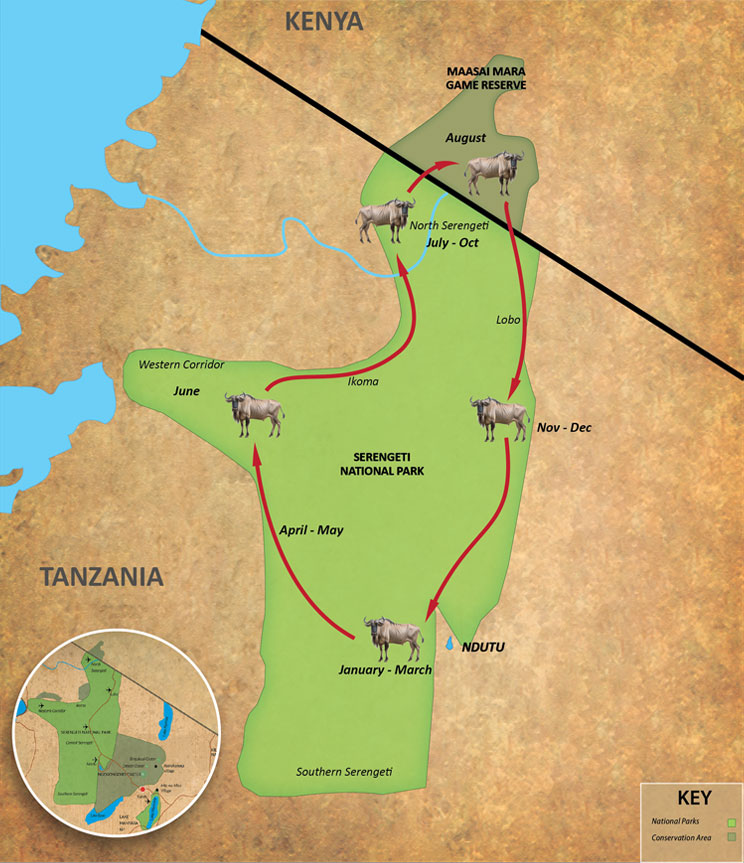Great Migration Tours
SERENGETI'S GREAT MIGRATION
The Great Migration is a breathtaking spectacle that showcases Africa’s most famous and incredible wildlife event. Over 2.5 million wildebeests, zebras, and antelopes travel in a majestic clockwise pattern around the Serengeti and Maasai Mara ecosystems in search of water and green pasture. Covering over 1,200 miles annually at predictable times, this migration is also a time for mating and birthing, adding to the natural wonder of this remarkable journey.
Why is it called “The Serengeti Migration”?
The Great Migration, also known as “The Serengeti Migration,” is an annual event that can be observed in the Serengeti throughout the year. While the Migration typically progresses towards Maasai Mara only in August, considerable herds of wildebeests still move between the Serengeti without stopping.
Why is the Great Migration Safari an Expensive Safari?
It’s important to keep in mind that safari packages that include tracking the Wildebeest Migration are typically more expensive. This is because most of your safari days will be spent in the Serengeti (3 nights), one of the most expensive safari destinations. Furthermore, accommodations near where the Migrations settle are scarce. Most lodgings are mobile camps, which are generally more costly than permanent lodgings.

GREAT MIGRATION CYCLE
Late June to October - One of the Best Times to See the Great Migration!
The Great Migration takes place in the Northern Serengeti from July to October. In August, the Migration crosses the Mara River to Maasai Mara. The Mara River runs along the border of Tanzania and Kenya, separating the Serengeti National Park from the Maasai Mara National Reserve.
As the Maasai Mara Reserve is small, it cannot accommodate the Great Migration, resulting in the animals crossing back and forth in August. The Serengeti is a massive park that can accommodate a large amount of wildlife and is considered the best destination to track the Great Migration throughout the year.
July to October is the most exhilarating and awe-inspiring time to witness the Migration as they cross the Mara River while being pursued by hungry crocodiles. The Mara River crossing is not a single event but occurs throughout the dry season. Groups of varying sizes, ranging from a few hundred to tens of thousands, cross the river in both directions. The crossing rhythm is one of Earth’s most dramatic and iconic events.
Great Migration Safari From November to December
From late October, the Great Migration starts moving from the Northern Serengeti region to the Central Serengeti. After arriving in the Central Serengeti, they settle there until early to mid-December. Subsequently, in December, the Migration disperses across the Serengeti’s eastern border down to the south (Ndutu), preparing for the calving season that typically starts in January.
This is a great time to witness the Migrations, with big herds scattering across the endless green grassland of central Serengeti, while being hunted by predators. The Central Serengeti is home to spectacular prides of lions.
Great Migration from January to March - The Calving Season
During this time, Ndutu is the privileged host of the Great Migration, a spectacular part of the southern Serengeti and Ngorongoro ecosystems. As the migration arrives in Ndutu, the exclusive ‘the special Calving Season’ commences, with a quarter million newborn wildebeests born between January and February. This period offers an incredible opportunity to witness the drama of the hunt as predators target the vulnerable newborns.
Additionally, Ndutu is an exceptional location for observing cheetahs, leopards and other big cats. The area features diverse habitats such as swamps, woodland, soda lakes, and the renowned Serengeti short-grass plains. In addition to the vast herds of wildebeest and zebras, Ndutu boasts stunning acacia woodlands where various animal species thrive within this unique ecosystem.
Great Migration Safari From April & May
The Great Migration herds make their way back to the Central Serengeti in search of water and green pastures for grazing. During this time, the Central Serengeti experiences an extended and heavy rainy season. The migrating animals face significant challenges as they navigate territory inhabited by formidable predators such as lions, leopards, and cheetahs, who actively capitalize on prey abundance. This makes the Great Migration a true test of survival for both the herbivores and the carnivores in the Central Serengeti.
Great Migration June
In June, the Great Migration takes place in the western corridor of the Serengeti. It showcases striking scenes of vast herds of wildebeests and zebras bravely crossing the perilous Grumeti River. During the crossing, they confront hungry crocodiles lurking beneath the water’s surface. The inexperienced young wildebeests and zebras are easy targets for patient predators. The turbulent waters of the Grumeti River pose another threat, leading to tragic drownings and the downstream drift of animals.
Special Notes
The circular migration pattern of wildebeests generally remains consistent. However, any changes in the climate may alter this pattern, resulting in the migration movement occurring ahead of schedule or being delayed. These changes impact late June to early July, late October to early November, and December. Rest assured, our team can provide expert advice on where to optimize your chances of witnessing the Migration, so there’s no need to be concerned.
